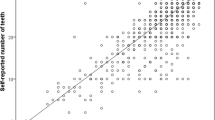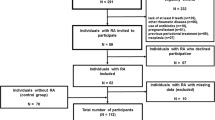Abstract
The reproducibility and validity of self-perceived periodontal, dental, and temporomandibular joint (TMJ) conditions were investigated. A questionnaire was applied in interview to 200 adults aged from 35 to 44, who were attending as casual patients at Araraquara School of Dentistry, São Paulo State University, São Paulo, Brazil. Clinical examination was based on the guidelines of the World Health Organization manual. The interview and the clinical examination were performed in two occasions, by a calibrated examiner. Reproducibility and validity were, respectively, verified by kappa statistics (κ) and sensitivity (Sen) and specificity (Spec) values, having clinical examination as the validation criterion. The results showed an almost perfect agreement for self-perceived TMJ (κ = 0.85) and periodontal conditions (κ = 0.81), and it was substantial for dental condition (κ = 0.69). Reproducibility according to clinical examination showed good results (κ = 0.73 for CPI index, κ = 0.96 for dental caries, and κ = 0.74 for TMJ conditions). Sensitivity and specificity values were higher for self-perceived dental (Sen = 0.84, Spec = 1.0) and TMJ conditions (Sen = 1.0, Spec = 0.8). With regard to periodontal condition, specificity was low (0.43), although sensitivity was very high (1.0). Self-perceived oral health was reliable for the examined conditions. Validity was good to detect dental conditions and TMJ disorders, and it was more sensitive than specific to detect the presence of periodontal disease.

Similar content being viewed by others
References
Buhlin K, Gustafsson A, Andersson K, Hakansson J, Klinge B (2002) Validity and limitations of self-reported periodontal health. Community Dent Oral Epidemiol 30:431–437
Burt BA (1997) How useful are cross-sectional data from surveys of dental caries? Community Dent Oral Epidemiol 25:36–41
Fricton JR, Schiffman EL (1986) Reproducibility of a craniomandibular index. J Dent Res 65:1359–1364
Fricton JR, Schiffman EL (1987) The craniomandibular index: validity. J Prosthet Dent 58:222–228
Fyffe HE, Deery C, Nugent ZJ, Nuttall NM, Pitts NB (2000) In vitro validity of the Dundee Selectable Threshold Method for caries diagnosis (DSTM). Community Dent Oral Epidemiol 28:52–58
Gilbert AD, Nuttall NM (1999) Self-reporting of periodontal health status. Br Dent J 186:241–244
Heft MW, Gilbert GH, Shelton BJ, Duncan RP (2003) Relationship of dental status, sociodemographic status, and oral symptoms to perceived need for dental care. Community Dent Oral Epidemiol 31:351–360
Jamieson LM, Thomson WM (2002) The dental neglect and dental indifferences scales compared. Community Dent Oral Epidemiol 30:168–175
Joshipura KJ, Douglass CW, Garcia RI, Valachovic R, Willett WC (1996) Validity of a self-reported periodontal disease measure. J Public Health Dent 56:205–212
Landis JR, Koch GG (1977) An application of hierarchical kappa-type statistics in the assessment of majority agreement among multiple observers. Biometrics 33:363–374
Leão A, Sheiham A (1995) Relation between clinical dental status and subjective impacts on daily living. J Dent Res 74:1408–1413
Light RJ (1971) Measures of response agreement for quantitative data: some generalizations and alternatives. Psychol Bull 76:365–377
Locker D (1996) Applications of self-reported assessments of oral health outcomes. J Dent Educ 60:494–500
Lundegren N, Axtelius B, Hakansson J, Akerman S (2004) Dental treatment need among 20 to 25-year-old Swedes: discrepancy between subjective and objective need. Acta Odontol Scand 62:91–96
Newell SA, Girgis A, Sanson-Fisher RW, Savolainen NJ (1999) The accuracy of self-reported health behaviors and risk factors relating to cancer and cardiovascular disease in the general population: a critical review. Am J Prev Med 17:211–229
Nilsson IM, List T, Drangsholt M (2006) The reliability and validity of self-reported temporomandibular disorder pain in adolescents. J Orofac Pain 20:138–144
Organización Mundial de la Salud (1997) Encuestas de salud bucodental: métodos básicos, 4th edn. OMS, Genebra
Palmqvist S, Söderfeldt B, Arnbjerg D (1991) Self-assessment of dental conditions: validity of a questionnaire. Community Dent Oral Epidemiol 19:249–251
Pitiphat W, Garcia RI, Douglass CW, Joshipura KJ (2002) Validation of self-reported oral health measures. J Public Health Dent 62:122–128
Reisine ST, Bailit HL (1980) Clinical oral health status and adult perceptions of oral health. Soc Sci Med 14A:597–605
Robinson PG, Nadanovsky P, Sheiham A (1998) Can dental questionnaires replace clinical surveys to assess dental treatment needs of adults? J Public Health Dent 58:250–253
Tormo MJ, Navarro C, Chirlaque MD, Barber X (2000) Validation of self diagnosis of high blood pressure in a sample of the Spanish EPIC cohort: overall agreement and predictive values. EPIC Group of Spain. J Epidemiol Community Health 54:221–226
Unell L, Söderfeldt B, Halling A, Paulander J, Birkhed D (1997) Oral disease, impairment, and illness: congruence between clinical and questionnaire findings. Acta Odontol Scand 55:127–132
Acknowledgments
The authors would like to thank Fundação de Amparo à Pesquisa do Estado de São Paulo/FAPESP. This study was supported by research grants number 02/07615-6 and 03/07271-8.
Author information
Authors and Affiliations
Corresponding author
Rights and permissions
About this article
Cite this article
Pinelli, C., de Castro Monteiro Loffredo, L. Reproducibility and validity of self-perceived oral health conditions. Clin Oral Invest 11, 431–437 (2007). https://doi.org/10.1007/s00784-007-0133-0
Received:
Accepted:
Published:
Issue Date:
DOI: https://doi.org/10.1007/s00784-007-0133-0




